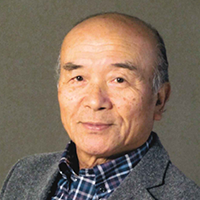Screen for tea ceremony brazier with sunago decoration.
- Sunagowork
- Presented in 2014
- H 73.0 x W 188.0 cm
- Contact for Price
| Category | Sunagowork |
|---|---|
| Year Presented | 2014 |
| Dimensions | H 73.0 x W 188.0 cm |
| Exhibition | The 61th Japan Traditional Kōgei Exhibition |
-
Sunagowork
Sunago is a traditional technique to draw patterns with gold and silver leaf made into fine, sand-like powder using a bamboo cylinder with a mesh net set in the bottom.
The gold / silver powder is dusted on to a sheet of paper where animal glue is applied, and is pressed down lightly with Japanese paper.
Sunago has been used to decorate picture scrolls and writings such as handwritten copies of sutras since the end of the Heian period (794 - 1185), and in the Edo period (1603 - 1868), it was also used to decorate folding screens and fusuma (sliding paper doors) paintings. Today, sunago techniques are used for decorating fusuma and other crafts such as furosaki byobu, a folding screen used for a summer-style tea ceremony.
Tatsuo Nagaoka

Production of sunagowork using real gold started during the Tempyo period (710-794), and the techniques were completed in the Heian period (794-1185). Sunagowork can be seen in national treasures such as Heike Nokyo (sutras dedicated by the Taira family) and Sanjurokuninkashu (manuscript of Japanese poems written by the 36 master poets). From then on, the sunago techniques were improved and passed down to this day as a traditional craft unique to Japan. The sensibility of Japanese people developed sunagowork through times. I want to produce refined, elegant sunagowork to match our modern life style.

